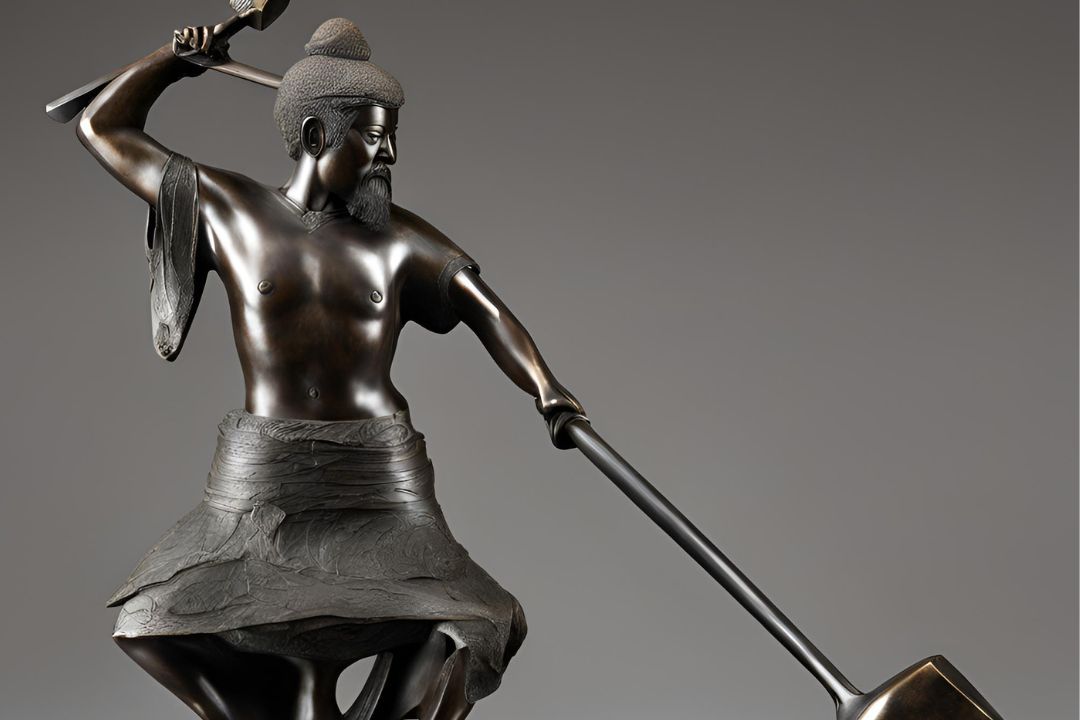Ikoku With Hammer Japanese Bronze Sculpture: A Masterpiece of
Introduction
When it comes to the timeless beauty of Japanese sculpture, one piece that stands out is the Ikoku With Hammer bronze sculpture. Known for its intricate craftsmanship and deep cultural significance, this unique work of art combines traditional Japanese techniques with a profound aesthetic that speaks to the soul. In this article, we’ll explore the history, features, and cultural impact of the Ikoku With Hammer sculpture.
What is Ikoku With Hammer Japanese Bronze Sculpture?
The Ikoku With Hammer Japanese bronze sculpture is a stunning example of Japanese artistry and craftsmanship. Created using a centuries-old method of casting, this bronze piece is characterized by its striking design, which often includes bold imagery of a hammer, symbolizing strength, craftsmanship, and determination. But beyond its physical form, the sculpture holds deep cultural and artistic meaning within the world of Japanese fine art.
The History Behind Ikoku Sculptures
Ikoku bronze sculptures have a rich history that dates back to ancient Japan. While their precise origins are debated, these works are rooted in Japan’s deep connection with metalworking, a craft that has flourished for over a thousand years. Historically, bronze was used for a variety of purposes in Japan, from ceremonial items to tools and weapons. The artistry of sculpting bronze evolved over time, and the Ikoku style emerged as a unique fusion of traditional techniques and evolving artistic expressions.
The Art of Bronze Sculpture in Japan
Japanese bronze sculpture is renowned for its meticulous craftsmanship and attention to detail. Artists of this genre use a lost-wax casting technique, where a model is created in wax, then covered in clay, and heated until the wax melts away, leaving a hollow mold. Molten bronze is then poured into the mold to form the final sculpture. This method, known as “lost-wax casting,” allows for incredibly detailed and complex designs, a hallmark of the Ikoku With Hammer bronze sculpture.
Features of the Ikoku With Hammer Sculpture
What makes the Ikoku With Hammer sculpture so special are its intricate features, blending form and symbolism in a way that resonates with viewers. The sculpture’s design and craftsmanship reveal a dedication to both aesthetics and deeper meaning.
Bronze Craftsmanship
One of the most striking features of the Ikoku sculpture is its high-quality bronze craftsmanship. The artist’s skill in handling the molten metal results in a piece that is not only durable but also visually stunning. The smooth yet textured surface of the bronze, combined with fine details, gives the sculpture a life of its own, reflecting light and shadow in a way that enhances its presence.
Design Elements
The design elements of Ikoku With Hammer sculptures are carefully thought out to reflect the broader themes of Japanese art. These pieces often incorporate stylized shapes and forms inspired by nature, such as flowing lines that mimic water or curves that echo the shapes of trees. The hammer itself, a recurring motif, stands as a symbol of strength and persistence, reminding viewers of the value of hard work and craftsmanship.
The Hammer Motif
The hammer motif in the Ikoku With Hammer sculpture is one of its most distinctive features. In Japanese culture, the hammer is seen as a symbol of labor, perseverance, and craftsmanship. It represents not only the physical strength required to shape metal but also the mental fortitude needed to create art. The hammer motif links the artist’s journey with the viewer’s experience, making the sculpture an interactive exploration of effort and artistry.
Cultural Significance of Japanese Bronze Sculptures
Japanese bronze sculptures are much more than just objects of beauty—they carry deep cultural significance. Their symbolism and history reflect the values and ideals of Japanese society, from respect for nature to the importance of hard work and craftsmanship.
Symbolism in Japanese Art
In Japanese art, symbolism plays a crucial role in conveying meaning. Objects, animals, and even natural elements often represent deeper themes of life, death, and the interconnectedness of all things. The Ikoku With Hammer sculpture embodies these principles, with the hammer symbolizing strength, resilience, and the enduring nature of human endeavor.
Bronze as a Medium for Japanese Artists
Bronze has long been a revered medium for Japanese artists. The metal’s durability, ability to hold fine details, and rich, warm tones make it ideal for sculptures meant to last for centuries. Historically, bronze was used in many aspects of Japanese life, from religious icons to functional tools. Today, it remains a symbol of tradition and excellence in Japanese art.
How Ikoku With Hammer Reflects Japanese Aesthetics
Japanese aesthetics emphasize simplicity, elegance, and harmony with nature. The Ikoku With Hammer sculpture is a prime example of how these principles manifest in art.
Simplicity and Elegance in Design
One of the most defining characteristics of Japanese art is its focus on simplicity and elegance. The Ikoku With Hammer sculpture, despite its striking form, adheres to these ideals by emphasizing clean lines, smooth curves, and a harmonious composition. The elegance of the piece comes not from extravagance but from its ability to convey deep meaning through understated beauty.
Harmony with Nature
Nature plays an essential role in Japanese art, and the Ikoku With Hammer sculpture is no exception. The flowing lines and organic shapes of the sculpture echo the natural world, creating a sense of balance between human-made craftsmanship and the environment. This harmony between the man-made and natural world is a key tenet of Japanese aesthetics, demonstrating a deep respect for nature.
The Influence of Ikoku Sculptures on Modern Art
The legacy of Ikoku bronze sculptures continues to influence contemporary artists and collectors alike. These sculptures have not only stood the test of time but also helped shape the trajectory of modern art.
Ikoku Sculptures in Contemporary Exhibits
Today, Ikoku With Hammer sculptures are featured in art galleries and exhibitions around the world. Their intricate design, historical significance, and timeless beauty make them sought-after pieces in the world of fine art. Many contemporary artists look to Ikoku sculptures for inspiration, drawn to the seamless blending of tradition and innovation.
The Impact on Collectors and Art Enthusiasts
For collectors and art enthusiasts, owning a piece like the Ikoku With Hammer sculpture is a way to connect with Japan’s rich cultural heritage. These sculptures represent not just a piece of art but a story, an embodiment of Japanese values, and a unique perspective on craftsmanship and creativity.
Conclusion
The Ikoku With Hammer Japanese bronze sculpture is more than just a piece of art; it’s a symbol of craftsmanship, perseverance, and cultural heritage. Through its intricate design and profound symbolism, it offers a window into the soul of Japanese art, reflecting the values and aesthetics that have shaped the country’s artistic legacy. Whether you’re an art lover, collector, or simply someone interested in Japanese culture, the Ikoku With Hammer sculpture is a powerful reminder of the beauty that can emerge from skill, tradition, and dedication.
FAQs
What does the hammer motif represent in Ikoku bronze sculptures?
The hammer symbolizes strength, perseverance, and the craftsmanship involved in creating the piece.
How long have bronze sculptures been used in Japanese art?
Bronze has been used for centuries in Japan, with its use evolving from tools and religious items to fine art.
What is the significance of nature in Ikoku bronze sculptures?
Nature influences the design and symbolism of the sculpture, reflecting the Japanese aesthetic of harmony with the environment.
Why are Ikoku sculptures considered so valuable in the art world?
Their intricate craftsmanship, cultural significance, and timeless beauty make them highly sought-after by collectors and art enthusiasts.
How does the Ikoku With Hammer sculpture reflect Japanese values?
It embodies values such as strength, hard work, simplicity, and a deep respect for nature, all of which are core aspects of Japanese culture.







